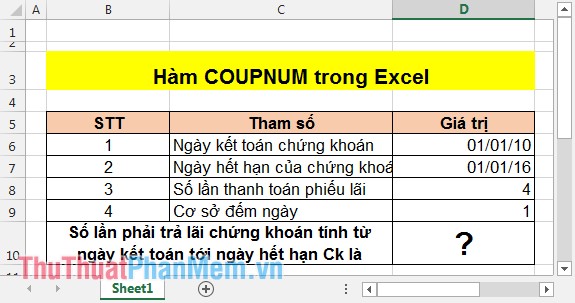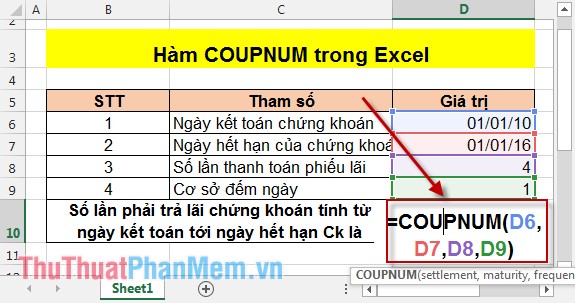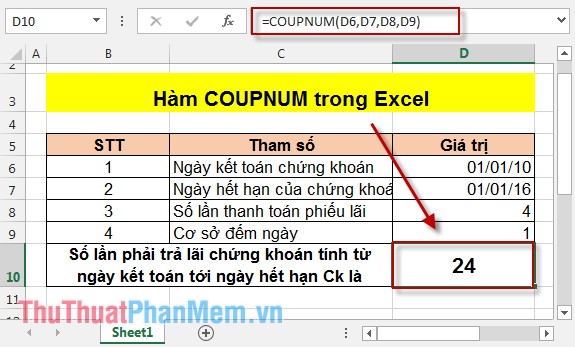COUPNUM function - The function returns the number of interest payments on a security in Excel
In the process of investing in securities, paying special interest is very important. It helps you calculate and plan a reasonable calculation and investment. The following article details the COUPNUM function - The function returns the number of interest payments of securities in excel.
Description: The function returns the number of interest payments from the settlement to maturity date. If the value is returned as a decimal, the function automatically rounds that value.
Syntax: COUPNUM (settlement, maturity, frequency, [basis]) .
Inside:
- settlement : The settlement date of a security or the date securities are sold to buyers after the issue date, which is a required parameter.
- maturity : The maturity date or the expiry date of a security, is a required parameter.
- frequency : The number of annual interest payments, is a required parameter, with the following values:
+ frequency = 1 => Pay interest 1 time per year.
+ frequency = 2 => Pay interest twice a year.
+ frequency = 4 => Quarterly interest payment.
- basis : Is the basis used to determine counting the number of days, is an arbitrary parameter. The following values are available:
+ basis = 0 or skip: Calculate the number of days based on US standards: The number of days per month is 30 / number of days per year is 360.
+ basis = 1: The actual number of days per month / The number of actual days per year.
+ basis = 2: The actual number of days per month / the number of actual days per year is 360 days.
+ basis = 3: The actual number of days per month / The number of days of the year is 365 days.
+ basis = 4: Number of days per month is 30 days / 360 days per year according to European standards.
Attention:
- If the return value of the function is a decimal, the function automatically rounds that value.
- Use the Date function (year, moth, day) to enter monthly values, avoid unnecessary confusion.
- If the parameter value is decimal => the function will take the integer value of that parameter.
- The function returns the error value #NUM! In the following cases:
+ If the settlement date and securities expiry date are invalid.
+ If the basis value is outside the set {0, 1, 2, 3, 4}.
+ If the settlement value is outside the values {1, 2, 4}.
+ If the settlement date is greater than the securities expiry date.
For example:
Calculating the number of interest payment times from the settlement date of securities to the expiry date of the securities knows the number of expiry dates, settlement and some facts as follows:

In the cell to calculate enter the following formula: = COUPNUM (D6, D7, D8, D9) .

Results after calculation:

Thus, from the settlement date of securities to the expiry date, securities have to pay interest 24 times.
The above is a detailed guide on how to use the COUPNUM function to help you when deciding to invest in the securities sector.
Good luck!
You should read it
- RANK.AVG function - The function returns the rank of a number in a list of numbers in Excel
- PERMUT function - The function returns the number of permutations of a given number of objects in Excel
- The DAYS function - The function returns the number of days between 2 dates in Excel
- GAMMA function - The function returns the gamma function value in Excel
- FVSCHEDULE function - Returns the future value of an investment that has variable or adjustable interest in period in Excel
- POISSON.DIST function - The function returns the Poisson distribution in Excel
- NPER function - The function calculates the period number of an investment in Excel
- PMT function in Excel - Usage and examples
May be interested
- PERMUTATIONA function - The function returns the number of permutations (can be repeated) of a given object in Excel
 permutationa function: the function returns the number of permutations (can be repeated) of a given object. support functions from excel 2013 onwards. syntax: permutationa (number, number_chosen)
permutationa function: the function returns the number of permutations (can be repeated) of a given object. support functions from excel 2013 onwards. syntax: permutationa (number, number_chosen) - GAMMA function - The function returns the gamma function value in Excel
 gamma: the function returns the gamma function. support functions from excel 2013 onwards. syntax: gamma (number)
gamma: the function returns the gamma function. support functions from excel 2013 onwards. syntax: gamma (number) - POISSON.DIST function - The function returns the Poisson distribution in Excel
 poisson.dist function: the function returns the poisson distribution, the application function to predict the number of events in a specific time. support functions from excel 2013 onwards. syntax: poisson.dist (x, mean, cumulative)
poisson.dist function: the function returns the poisson distribution, the application function to predict the number of events in a specific time. support functions from excel 2013 onwards. syntax: poisson.dist (x, mean, cumulative) - RANK.EQ function - Function returns the rank of a number in a list of numbers, returns the highest rank when multiple values with the same rank in Excel
 rank.eq function: the function returns the rank of a number in a list of numbers whose size is in correlation with other values. if multiple values have the same rank -> the function returns the highest rank. support functions from execl 2010 version onwards.
rank.eq function: the function returns the rank of a number in a list of numbers whose size is in correlation with other values. if multiple values have the same rank -> the function returns the highest rank. support functions from execl 2010 version onwards. - SHEETS function - The function returns the number of pages in a reference in Excel
 sheets function: the function returns the number of pages in a reference. support functions from excel 2013 onwards. syntax: sheets (reference)
sheets function: the function returns the number of pages in a reference. support functions from excel 2013 onwards. syntax: sheets (reference) - BETA.DIST function - The function returns the Beta distribution in Excel
 beta.dist function: the function returns the beta distribution to study the variability of a number of things through a sample. support functions from excel 2010 onwards. syntax: beta.dist (x, alpha, beta, cumulative, [a], [b])
beta.dist function: the function returns the beta distribution to study the variability of a number of things through a sample. support functions from excel 2010 onwards. syntax: beta.dist (x, alpha, beta, cumulative, [a], [b]) - The SQRT function returns the square root of a positive number in Excel
 the sqrt () function in excel helps you quickly calculate the square root of any number you want. the syntax and usage of the function is very simple, but if you do not know, follow the article below.
the sqrt () function in excel helps you quickly calculate the square root of any number you want. the syntax and usage of the function is very simple, but if you do not know, follow the article below. - How to use ADDRESS function in Excel
 the address function in excel takes the number of rows and column numbers as arguments and returns the reference of the standard cell (cell address). for example, if you go to row 4 and column 3, the function returns c4.
the address function in excel takes the number of rows and column numbers as arguments and returns the reference of the standard cell (cell address). for example, if you go to row 4 and column 3, the function returns c4. - POISSON function - The function returns the Poisson distribution in Excel
 in predicting the number of events that occur within a specific time, one cannot help but use the poisson function. the following article details how to use the poisson function, the function returns the poisson distribution.
in predicting the number of events that occur within a specific time, one cannot help but use the poisson function. the following article details how to use the poisson function, the function returns the poisson distribution. - MONTH function - The function returns the monthly value of a day expressed as a serial number in Excel
 month function: the function returns the month of a day expressed as serial number in excel. months are represented by integers with values between 1 and 12 months. syntax: month (serial_number)
month function: the function returns the month of a day expressed as serial number in excel. months are represented by integers with values between 1 and 12 months. syntax: month (serial_number)










 DURATION function - The function returns the periodic periodic interest payments in Excel
DURATION function - The function returns the periodic periodic interest payments in Excel EFFECT function - The function of calculating the annual real interest rate in Excel
EFFECT function - The function of calculating the annual real interest rate in Excel NORMDIST function - The function returns the normal distribution with the standard deviation and the average value specified in Excel
NORMDIST function - The function returns the normal distribution with the standard deviation and the average value specified in Excel NORMSDIST function - The function returns the normal cumulative distribution in Excel
NORMSDIST function - The function returns the normal cumulative distribution in Excel SUBSTITUTE function - The function replaces text strings in Excel
SUBSTITUTE function - The function replaces text strings in Excel CHITEST function - The function returns the independence test in Excel
CHITEST function - The function returns the independence test in Excel